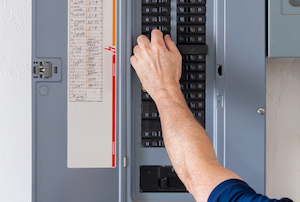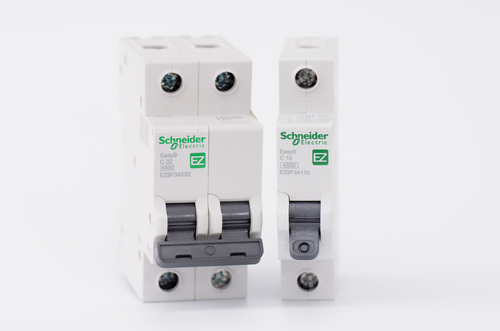How To Read a Circuit Breaker Panel

Figure 1: Circuit breaker panel showing the main panel (bottom), subpanels (top), and labels (left).
Circuit breaker panels distribute power and protect the circuits from overloading and short circuits. The panel's labeling provides vital information about the circuits and their corresponding breakers, enabling users to identify and troubleshoot electric faults quickly and safely. This article explores the main parts of a circuit breaker panel, decoding its labels, and the preventive methods to adopt while working on the panel.
Table of contents
- Circuit breaker panel
- Checking the labels on the breaker panel
- Label on the circuit breaker
- Safety precautions when handling a circuit breaker
- FAQs
View our online selection of circuit breakers!
Circuit breaker panel
A circuit breaker automatically interrupts the flow of current in an electrical circuit in the event of an over-current or short-circuit. The breaker prevents electrical fires and damage to electrical equipment. It is essential to understand the working of a circuit breaker panel, as it may be necessary to shut off the power to the building rapidly in case of an emergency, such as a fire or flood. Additionally, there may be times when you need to use the breaker box to access a circuit breaker that has tripped due to an overloaded circuit board caused by the simultaneous use of several appliances.
The circuit breaker panel, also known as an electrical panel or breaker box, typically looks like a metal box that is mounted on a wall in a utility room, basement, or garage. The panel usually has a hinged door protecting the circuit breakers inside.
Here is a summary of the various components of an electric panel.
-
Main breaker: The main breaker controls electricity distribution to a building. It receives power from the utility company and diverts it to individual circuits that power different household devices, like lights, appliances, and outlets. Except for the incoming utility power, all other electrical power at home can be controlled via the main service panel, allowing for convenient on-and-off switching.
- If the main breaker is on the circuit panel, it is usually situated at the top or bottom of the panel (Figure 1). If it is not on the circuit panel, it is likely positioned next to the electricity meters.
- The two wires from the electric meter connect to the lugs on the main breaker.
- The main breaker provides overcurrent protection to the property. It is rated to handle a certain amount of electrical current passing through it (approximately 100 - 200 A). If this value is exceeded, it will trip automatically to protect the electrical circuits.
- Two main bus bars come out of the main breaker. These are exposed metal sheets that carry electricity to the circuit breakers. The circuit breakers can be single-pole or double-pole (Figure 2).
- Empty slots: Empty slots in a circuit panel can be used for additional appliances or other electrical needs.
- Subpanels: When making additions to a home, an electrician will put in a smaller, secondary breaker box specifically for the new area. Just like the main breaker box, it's crucial to be aware of which rooms or appliances are connected to the circuits in the sub-panel.

Figure 2: Double-pole breaker (Left) and single-pole breaker (Right)
Checking the labels on the breaker panel
The circuits are generally labeled during the initial wiring installation. The labels are next to each switch or inside the breaker panel door (Figure 1). They are numbered to correspond with their respective switch and may refer to specific appliances or rooms in the circuit.
The labels on an electrical panel breaker box help during an emergency if you lose power to a particular room or appliance. For instance, if the breaker that provides electricity to the stove or oven trips, you can check the label and identify the circuit breaker that connects to the oven. Similarly, during an emergency, it may be essential to turn off the power to certain appliances; in this case, check the labels corresponding to the appliance and switch the breaker off.
Switches are not labeled
Labeling circuits makes it easy to identify which switches to turn on and off in the event of a circuit trip or if a specific breaker needs to be turned off In case the circuit breakers are not labeled, follow these steps to label your breaker panel:
- Turn off all the circuits except for one.
- Walk around the house and test the lights and outlets to see which ones still work. Use a small lamp or electronic device to check outlets quickly.
- Once you have identified the room or rooms on the circuit, return to the breaker panel and label the switch accordingly.
- Repeat this process for each switch until they are labeled.
Label on the circuit breaker
The label on a circuit breaker typically includes information related to the brand, serial number, and electrical specifications. These parameters vary depending on the brand. A typical circuit breaker label contains the following:
- Brand name and serial number
- Maximum amperage rating, which is often denoted as 5KA or 10KA which indicates the maximum current it can trip.
- Voltage rating of 110 VAC, 220 VAC, or 240 VAC. The voltage rating can vary as different countries use different supply voltages.
- Frequency (Hz) rating refers to the line frequency the breaker can handle. The standard line frequency for most of the world is 50 Hz, but in America and some parts of Asia, it is 60 Hz. For more details, see the complete list of countries with their corresponding mains power supply voltage and operating frequencies.
- Trip curve details. For example, in Figure 3, the 'C' in C25 refers to the characteristic of the circuit breaker, which indicates the trip curve or how quickly it will trip in response to an overcurrent. The trip curve for a circuit breaker typically includes two main parameters: the current level and the trip time. Different types of trip curves are used for different types of circuits and applications, and the C curve is typically used for circuits with moderate inrush currents, such as lighting and small motors. In addition to the C curve, there are B, D, K, and Z curves, depending on the application.

Figure 3: Label on a circuit breaker showing the voltage and current ratings and trip curve characteristics
Safety precautions when handling a circuit breaker
Understanding which circuit breaker controls what appliance and learning how to sort basic issues can help save money in the long run. However, safety comes first when working on a circuit breaker panel. The first step is to shut off either the individual circuit breaker for the circuit you are working on, or turn off the main breaker. This procedure ensures that equipment is appropriately switched off and can only be turned back on once the repair or maintenance work is complete. Common electrical hazards include burns, electrocution, shock, fire, and explosions. There are a few steps to follow to avoid these hazards.
- Follow manufacturer's instructions: Always read the instructions carefully before installing or using a circuit breaker. The instructions will provide important safety information and precautions you should know.
- Turn off the power: Before working on a circuit breaker or any electrical equipment, turn off the power. Use a voltage tester, like a multimeter, to ensure that the power is off before touching any wires or components.
- Wear protective gear: When working on circuit breakers or any electrical equipment, it is important to wear appropriate protective gear, such as gloves, safety glasses, and a face mask to protect against electrical shock and other hazards.
- Branch circuits: Don't overload circuits by connecting more devices than the circuits can handle. The breaker will automatically shut off and cut power flow if it detects a higher voltage than its allowance. Ensure that large power consumers, like HVAC systems, have dedicated circuits.
- Trips: Disconnect an appliance immediately if it switches off a breaker, short circuits, or blows a fuse. After unplugging the device, find the tripped breaker, which will be between on and off or entirely off. To reset it, switch it completely off and back on. If it doesn't restore power, try switching it off and on again. If this doesn't work, contact an electrician to check it out.
- Circuit breaker specifications: Use the right size or fuse for an amperage rating. Different circuit breakers have varying AMPs, depending on the appliances they are designed to supply power to. Typically, most breakers handle 15 to 20 AMPs, but some devices need more. For such appliances, get the correct breaker between 20 and 30 AMPs.
- Access: Keep clear access to the circuit breaker panel, and always keep a flashlight stationed in case you need to check it out in the darkness. Clear access makes resetting, repairing, or replacing breakers easier.
Read our articles on miniature circuit breakers, residual current circuit breaker, and earth leakage circuit breakers for more details on the features of various circuit breaker types.
FAQs
Do circuit breakers need to be labeled?
Yes, each circuit breaker should be labeled so that the circuit protected by the device can be easily identified.
What causes a circuit breaker to trip?
The main cause of tripping circuit breakers are overloads and short circuits.





